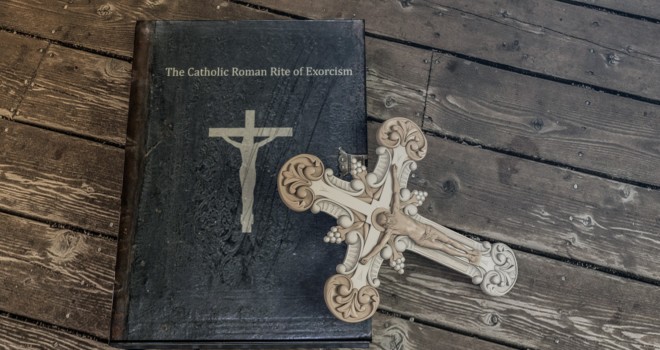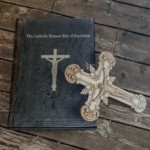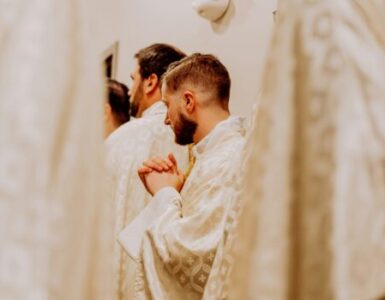Who was Father Amorth, and what was the secret of his priestly vocation?
In a 2015 interview in Credere, he revealed:
“My vocation was born early, around the age of ten or twelve. I was more or less Jesus’ age when he was found in the temple. One day, when all the family was at the table — my two saintly parents, my four brothers, and I — Papa asked us: ‘What do you wish to do when you are grown up?’ I responded first: ‘I will be a priest.’ And he said, nearly as if he expected it: ‘I shall be very content if it happens.’ ”
Papa Mario did not live to see his son a priest; he died in 1939, at the start of World War II.
In the summer of 1942, at the age of seventeen and at the height of the war, Amorth went to Rome, accompanied by his pastor, to visit some religious institutions. He first knocked on the door of the Passionists but, because of a misunderstanding, was not received. He then visited the Roman offices of the Society of St. Paul and was welcomed personally by Blessed Giacomo Alberione, who immediately recognized his Pauline vocation. “When I asked him which order I should choose, he said: ‘Tomorrow I shall celebrate a Mass for you and I shall ask the Lord.’ The next day he told me: ‘It is God’s will that you enter the Society of St. Paul.’ So I decided to finish my classical studies at the high school and then enter the Society of St. Paul.”

The funeral of Father Amorth was held in the great church of the Queen of the Apostles in the neighborhood of St. Paul. The celebrants were the auxiliary bishop Monsignor Paolo Lojudice and the superior general of the Society of St. Paul, Father Valdir José de Castro. There were a hundred priests concelebrating with them, among whom were numerous exorcists and the president of their international organization, Father Francesco Bamonte. At least fifteen hundred people attended the funeral; those not able to enter the church remained in the churchyard. At least a thousand people also waited all day Sunday and then Monday morning to file past the casket that was placed in the church next to the tomb of Blessed Giacomo Alberione, the founder of the Society of St. Paul.
People who had experienced Father Gabriele’s comfort and help in their illnesses came from all over Italy and beyond. Many of the participants of the numerous prayer groups that Father Gabriele followed in Rome were also there, as were the many that joined him in prayer for the exorcisms.
As a Pauline priest, Father Amorth fully lived his vocation as an apostle of communication from 1985 until his death. As a publicist, he promoted a deeper knowledge of the world of the occult and its remedies in the Church. As a molder of the young Pauline seminarians, he taught at the high school and was a spiritual director for diverse institutions (the Little Sisters of the Annunciation, the Gabrielines, and the members of the Institute of Jesus the Priest); and briefly, for a little less than two years, he was the Paulines’ delegate for Italy. Moreover, thanks to his wise pen, he was an appreciated journalist and editorialist. From 1980 to 1988, he directed the monthly Madre di Dio (Mother of God) and collaborated with the editors of Credere, Famiglia cristiana (The Christian family), Segno del soprannaturale (The sign of the supernatural), and other Pauline magazines. Then, for many long years, each second Wednesday of the month, he hosted the series An Exorcist Tells His Story on Radio Maria.
He became very well known internationally thanks to his books on the dangerous world of the occult and the destructive consequences it has on peoples’ lives. Also, on radio, on television, and in print, he addressed topics that were usually ignored, either because they were crushed by secular prejudices or because of the inattention of the Church. During his eulogy, ather Bamonte emphasized Amorth’s “tenacious and passionate attempts to reawaken the Church to the needs of persons who suffer in the spirit and therefore require the help of exorcists. It was Father Amorth, Father Bamonte recalled, who in 1991 gathered together all the Italian exorcists and then three years later founded the International Association of Exorcists, becoming its long-time president. The association’s statutes were recognized on June 13, 2014. “Its only objective,” Father Amorth emphasized, “was to obtain cures for the illnesses caused by demonic oppression.”
Never did he write a book, grant an interview, or appear in the media without having this objective in mind. Father Antonio Mattatelli, of Lucca, one of the youngest Italian exorcists writes: “Whenever someone told him that he was the most famous exorcist, he would respond: ‘The most famous but not the most effective.’ ” Father Amorth always referred to Father Matteo La Grua, another giant in the Catholic ministry of liberation, as the truest exorcist — and saint! But I believe that Father Amorth also was a saint, with his Modenese sincerity, always direct and never diplomatic. He was one who gave bread for bread. He was a master in every way: in chasing demons, in his ministry of the Word, and in his preaching and evangelization. He touched his listeners and his readers.
I was with Father Amorth one Tuesday morning when he was struggling with one of his patients in the Basilica of St. Paul Outside the Walls. He was sweating much from the heat, but also because of the fidgeting of the obsessions, so horrendous and at the same time fascinating. I witnessed this scene often; and each time, I was impressed with his familiarity with the procedure and with the throngs of people seeking him and asking him for help.
He received rivers of people in that “clinic of the spirit,” always in control, secure, and charitable, when, as if overseeing an assembly line, he performed exorcisms in industrial quantities.
No one knew where he got that serene, psychic strength and how he found the time — with all the exorcisms — to churn out books. Yet all of us understood that it was Christ (along with His Immaculate Mother) who was the secret flame of the energy he poured into our beloved Church — the Church, as Benedict XVI said at Fatima, “where the faith is being extinguished in the heart of so many believers because it is not being nurtured.”
I saw him for the last time in Rome, at the Paulines’ motherhouse. I was with some friends. I wished, above all, to ask him a question I could not answer about exorcisms, about the possibility that holy and saved souls could also manifest themselves, as devils do.
This field is difficult to understand and explain. But I wished to hear from him — the exorcist par excellence. And he answered me with his usual competence. “Yes,” he said to me, “the saints at times manifest themselves: it has happened to me with St. Gabriele of Our Lady of Sorrows, St. Benedict, and St. Padre Pio of Pietrelcina, whom I knew during his life.” Then he gave me a pat on the shoulder, adding: “Keep going, young man!”
Looking back, I am moved thinking of the beauty and greatness of that man, so lucid and wise but with an old, sick body that was going to ruin.
Father Antonio Rizzolo, director of the magazine Credere, remembers him, above all, as a person who has done much good for everyone: “I was struck by the gratitude expressed on the Internet by those thanking him for his ministry of exorcism, an undertaking he engaged in with dedication up until a few weeks ago, when his strength failed him. These simple, needy people found in him a compassionate listener.”
I would like to remember Father Amorth as my confrere, a fellow Pauline. He was indeed part of my congregation, the Society of St. Paul. But I began to know him better in 1989, when I collaborated with him at the magazine Madre di Dio, which he directed during its first year and then continued as a contributor.
In the end, this is one of the messages that Father Amorth left us: “The devil is nothing against the mercy of God.”
✠
This article is adapted from a chapter in The Devil is Afraid of Me: The Life and Work of the World’s Most Popular Exorcist. It is available as an ebook or paperback from Sophia Institute Press.
To read more about Fr. Amorth’s work, we’ve republished excerpts of his previous writing in the article “An Exorcist Explains Demonic Possession and Vexation” here on Catholic Exchange. You can also read Kathleen Beckman’s article, “Fr. Amorth: The Role of Mary & Angels Against Evil” here on CE.














